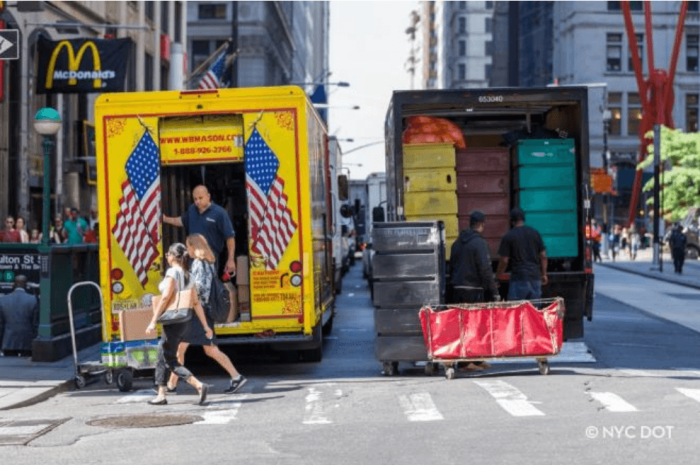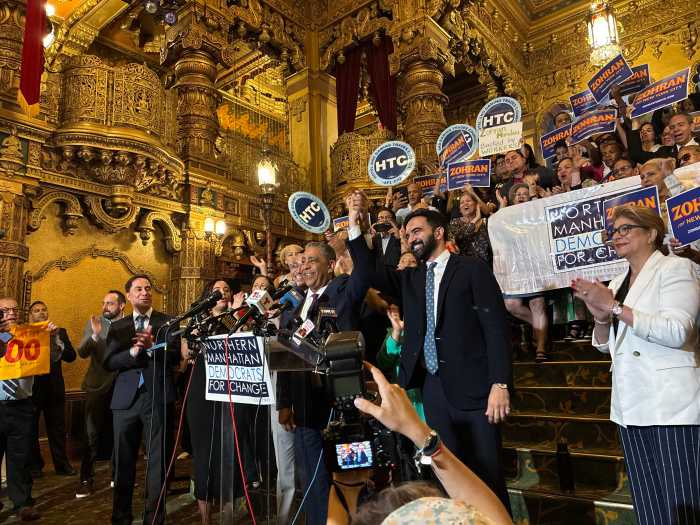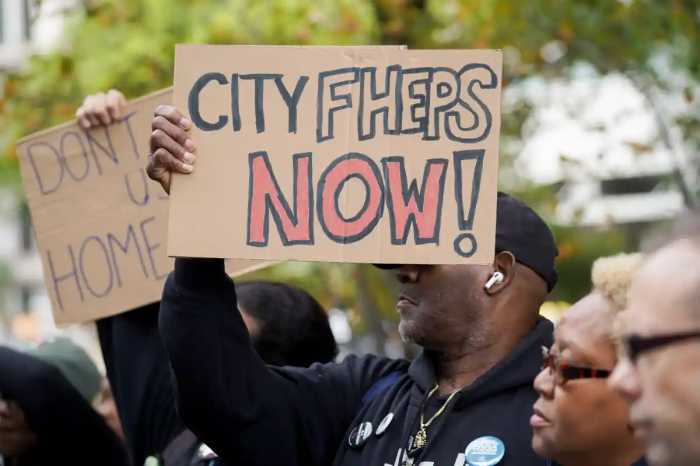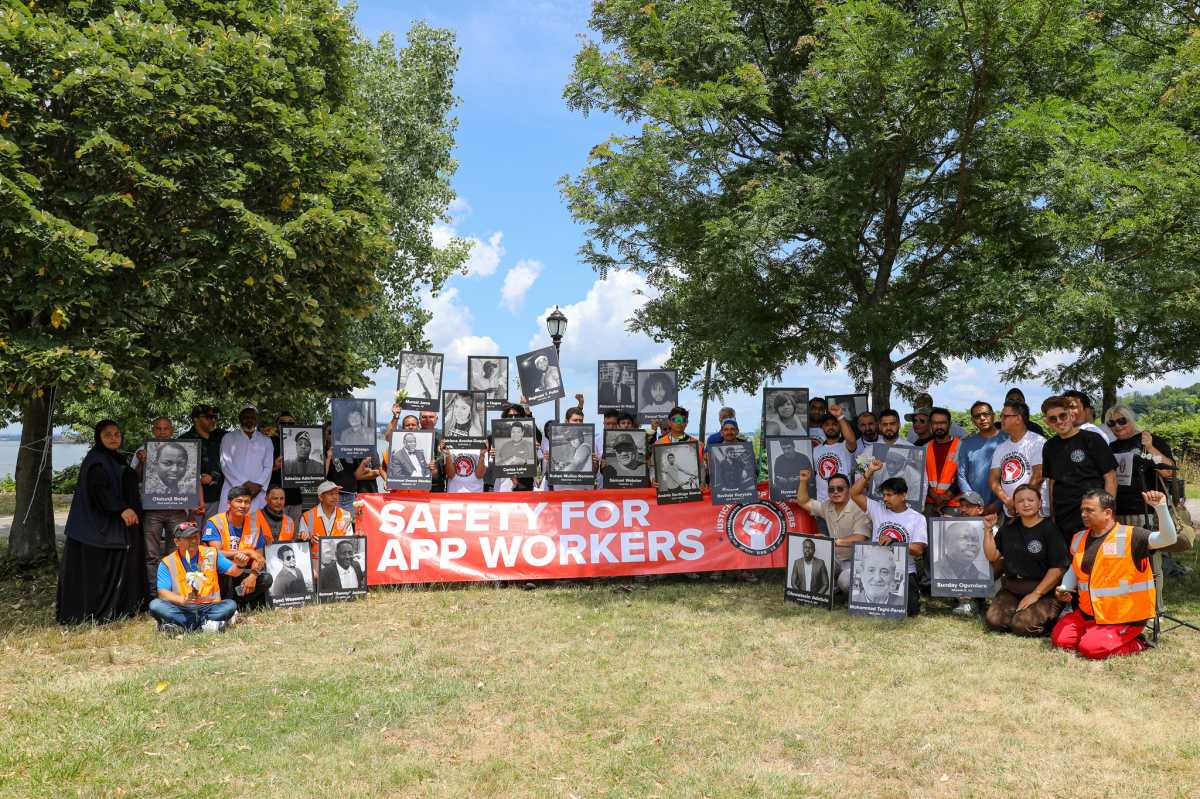The city’s Department of Transportation (DOT) will launch a pilot program this summer to place secure, public lockers on Big Apple sidewalks for sending and receiving packages, hoping to both cut down on rampant package theft and reduce the truck traffic and pollution associated with home deliveries.
LockerNYC, as the program is being called, will kick off this summer at 15 sidewalk locations across the city, which have yet to be determined, and will last for one year. Customers will be able to pick up or drop off parcels at the lockers 24/7. DOT is partnering with delivery companies like UPS, DHL, and Pitney-Bowes, which will do drop-offs and pickups at the centralized lockers in a manner the agency says will cut down on the number of trips made by delivery trucks.
“As the number of at-home deliveries have surged in recent years, so have the number of large delivery trucks on our city streets,” DOT Commissioner Ydanis Rodriguez said in a statement. “The LockerNYC initiative will help reduce the number of trips delivery trucks make each day while also providing a secure place for New Yorkers to receive packages.”
The pilot will be helmed by the company GoLocker, which will build the lockers and operate them. The company already operates nine lockers across the city — six in Brooklyn, two in Manhattan, and one in Queens — but charges customers to use them. Users can pay $5 per package on a pay-as-you-go basis or subscribe to premium options for $20 or $30 per month, which allow 10 and 20 deliveries per month respectively.
Unlike those, the lockers in the pilot will be free to use. GoLocker is conducting the pilot essentially without charge to taxpayers: an entry in the City Record, a database of municipal contracts, shows the city paid GoLocker just $1 for the “demonstration” program. DOT will collect data on the pilot to assess whether to expand it in the future.
Customers can access GoLocker facilities using a secure code sent by the company once a package is confirmed to be delivered. At that point, point users have 48 hours to pick up their wares.
DOT has not yet selected the sites where it will place the lockers, but says it will choose areas based on concentrations of residential buildings without secure mailrooms and on NYPD package theft data. Siting choices will be made to ensure the lockers don’t impede the flow of pedestrians or conflict with other street furniture, and to prevent obstruction of windows, fire escapes, or public art displays.

Each day, approximately 90,000 packages are reported stolen or lost in New York City, according to DOT. Many buildings lack secure areas to drop off and pick up packages, leaving them vulnerable to thieves.
At-home package delivery has greatly increased in the post-pandemic era. New Yorkers were receiving about 1.8 million packages per day pre-pandemic but that number surged to 2.3 million by the end of 2021, according to the Center of Excellence for Sustainable Urban Freight Systems at Rensselaer Polytechnic Institute. When including grocery and restaurant deliveries, the number of deliveries had reached 3.7 million by July 2022.
The city estimates about 80% of households receive at least one delivery per week and 20% receive four or more deliveries in each seven-day period.
All of that extra delivery has led to a surge in truck traffic on city streets and the proliferation of new, high-volume “last-mile” logistics facilities, which lawmakers are seeking to regulate. Truck traffic has been particularly pronounced in the areas around the warehouses, which are predominantly sited in “environmental justice communities” with disproportionately low-income and non-white populations that have historically borne the burdens associated with polluting industries in their neighborhoods.
DOT argues the centralized lockers will allow delivery companies to make fewer truck trips, reducing the number of vehicles on the road and thereby cutting down on congestion and carbon emissions. The agency cites a pilot program in Seattle that saw reductions in delivery time and dwell time for delivery trucks.
The World Economic Forum estimates that in the globe’s 100 largest cities, the number of delivery vehicles could go up 36%, emissions from delivery traffic could rise 32%, and congestion could jump 21% by 2030 without any interventions. The international NGO posits parcel lockers could decrease traffic congestion by up to 18% and reduce delivery costs by 12%, though the impact on carbon emissions is largely negligible.
In April, DOT announced a pilot would start this summer to test neighborhood delivery “microhubs” where large delivery trucks can offload their wares onto smaller-scale modes of transportation — such vans, cargo bikes, or even hand-pulled carts — for the final leg of the journey to the customer’s door, which typically involves travel on residential streets.
Officials have in recent years encouraged delivery companies to fulfill orders using cargo bikes and pledged to build out infrastructure facilitating delivery by rail or the city’s waterways, though it’s unclear to what extent, if at all, those have been adopted and stemmed the surge in truck traffic.
Read more: Woman Arrested for Pushing Teen onto Subway Tracks in Queens
































